
Children have a natural connection to the world around them. They develop deep and sometimes lifelong interests though their observations of nature, the weather, animals or technology. Their play is scientific in nature as they experiment with cause and effect and observe changes that take place in the natural environment. Trips to the local park where they might spot a weed in the paving slabs, a bug on a leaf, or have a conversation with a policeman, can spark rich learning opportunities. Through these interactions, children begin to make sense of their physical world and their community.
For education consultant Kathryn Solly, Understanding the World (UTW) underpins the whole EYFS. ‘Literacy, language, maths, physicality and personal, social and emotional development can all be accessed through children’s interests in the world around them. It’s motivational for children, and particularly important for children with additional needs, vulnerable children or those with English as a second language, who may struggle in other areas of learning, initially.’
NATURAL WORLD
Collections of natural materials, magnifying glasses for exploring minibeasts and experimenting with objects that float and sink in water are just some of the ways that practitioners can extend children’s learning in this area. Real-life experiences that children have observed on their travels can be recreated through role play, and open-ended resources can be used to recreate built environments, such as building sites or bridges.
‘Children’s interests are powerful,’ explains Solly. ‘I like to refer to my insect enthusiasts as “entomologists”, and my dinosaur experts as “palaeontologists”. It’s a great foundation on which to extend their knowledge and introduce new vocabulary.’
Through first-hand experiences, such as planting and harvesting fruit and vegetables, playing with natural materials such as sand, water and clay, cooking from scratch and using real tools, children learn to make connections. ‘They learn that the tomatoes they planted didn’t grow because there wasn’t enough sunlight, or they see the slugs have eaten the lettuce leaves,’ Solly says.
Adding technology can enhance the experience further. ‘Use a webcam to take videos of bird eggs hatching, or take photos of ladybird eggs and explore lifecycles back at the nursery. Recording devices embedded into technology, such as binoculars and clipboards, are great for documenting findings on-the-go,’ says TTS editor Michelle Reid.
PERSONAL EXPERIENCES
Developing a ‘sense of place’ is linked to a child’s sense of belonging in the world. ‘It’s not about ensuring they know the tiny details of the world, the local area, every feature and facet of the planet, every culture and all the activities that take place,’ explains Phil Armstrong, senior education lead at Early Excellence. ‘The aim is that the learning connections that the children make, both locally and globally, become personal, rich and sustained,’ he adds.
Start with what’s familiar to them: their homes, gardens and how they travel to nursery. Discussions around how many rooms they have, if they live in a flat or a house and what flowers or plants they have in the garden can spark conversations around similarities and differences in the way others live.
Get to know families, their heritage or the festivals they partake in, and ensure that resources reflect the diversity of life in modern Britain. Invite families or members of the community into the setting.
Likewise, practitioners can take children on visits to the post office, park or a gallery, mapping out their local environment and labelling points of interest such as signs and places of interest on the way.
Solly advises practitioners to be ‘open’ to taking children out into the community to extend their interests. ‘Think about providing meaningful experiences that the children can learn from. For children with a rotation schema, for example, take them to the supermarket to look at the conveyor belt, ensuring that you pre-warn the shop manager.’

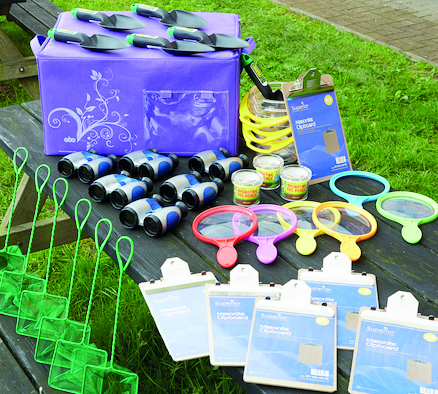
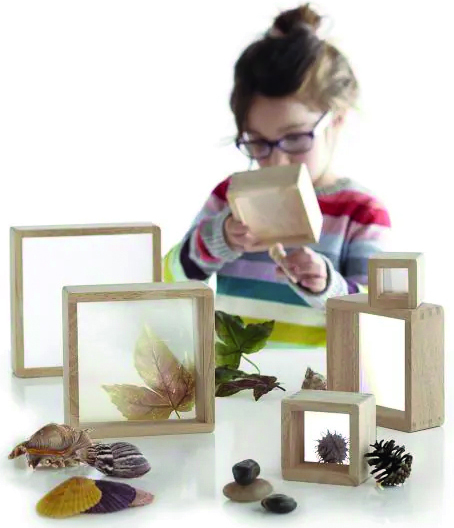
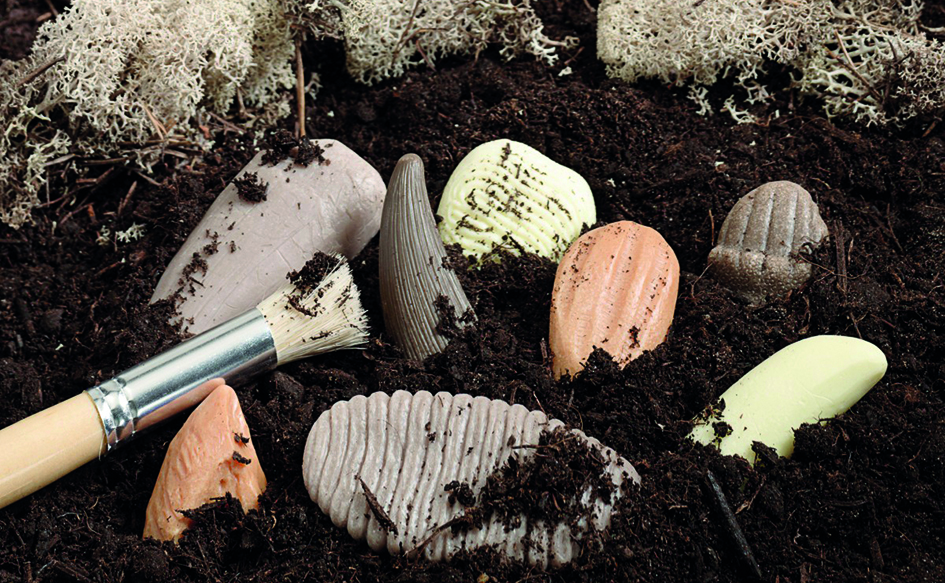
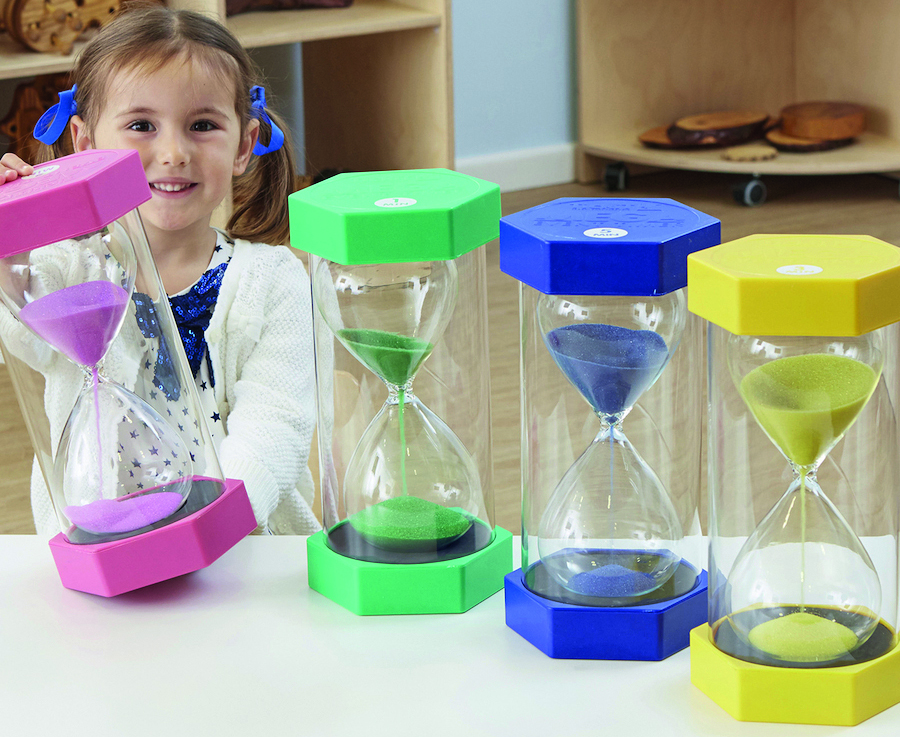
RESOURCES FOR UTW
- Help children develop a sense of time with TTS’s Recordable Talking Panel, £37.99, or its Mega Sand Timers (pictured overleaf, top right), from £29.99.
- Explore past and present with TTS’s Toys of the Past Collection, £64.99, or excite curious minds with its Dinosaur Bones Excavation Kit, £34.99. Budding palaeontologists will love to bury and dig up Yellow Door’s Let’s Investigate – Prehistoric Teeth, £22 (pictured below right, bottom), or compare the similarities and differences of the dinosaurs and their skeletons in its Dinosaur Wooden Characters, £35.
- Transform your home corner into a dentist’s, hairdresser’s, garage, post office or greengrocer’s with Cosy’s Open Ended Role Play Area, £415. Add its Biodegradable 79 piece Dinner Set, £48.99, along with its Home Corner Cleaning Set, £118.99.
- Early Excellence’s Exploring Nature Complete Collection, £345, contains wind toys, mini beast bug-hunt kits, tough spot trays and recording equipment to explore the natural world. Or try TTS’s Minibeast Grab and Go Kit, £149.99, and use TickiT’s Wooden Lifecycle Tiles, £29, to illustrate the developmental stages of humans, bees, frogs, apples, butterflies and chickens. Fill Cosy’s Explorer Shedlet, £169, with its Magnifying Glasses Set, £48.88, or its Magnification Blocks, £32.99 for six (pictured right).
- Wildlife gardens are great for learning about lifecycles and bird-watching. To attract birds, create bird feeders by pressing lard, nuts and seeds into pinecones or yoghurt pots and hang them from trees. Muddy Faces’ Singing Birds, Blue Tit, £7.99, is a soft toy with an authentic bird call. Or house frogs in its ceramic Frogilo Frog and Toad House, £24.99. Discover pond life with TickiT’s Telescopic Pond Net, £12.
- Use technology by trying TTS’s See and Speak Recordable Binoculars, £93.99, and its Easi-Detectors ICT Metal Detectors 4pk, £164.99.
- Offer quality literature such as Early Excellence’s Weather Book Set 3-7yrs, £29.95, or PlaytoZ’s We’re Sailing Down the Nile sensory tales set, £60.
CASE STUDY: Molesley Day Nursery, Surrey
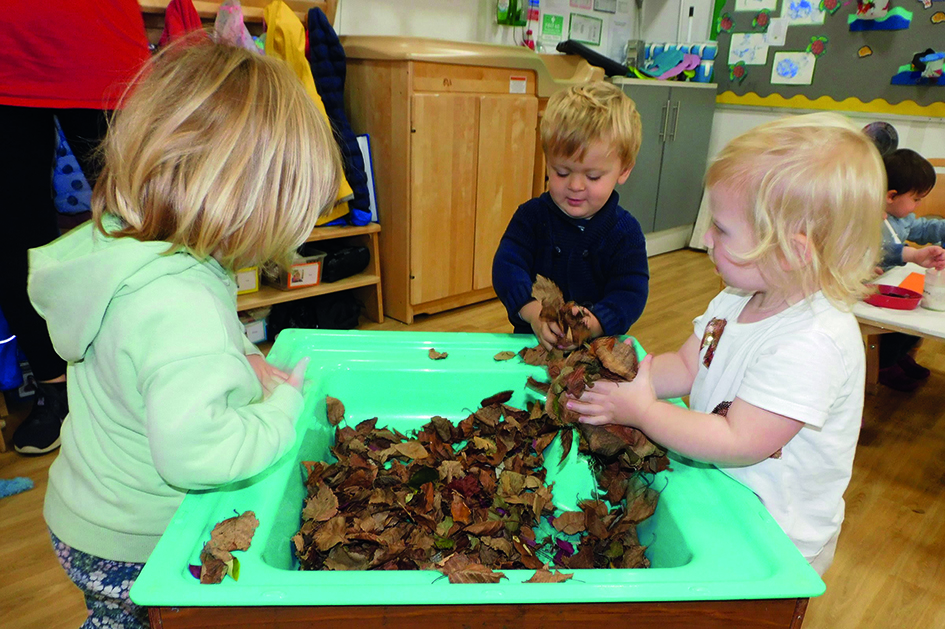 ‘Children have noticed changes in the outdoor natural environment recently, which has sparked discussions around autumn and seasonal changes,’ explains manager Kirsty Grant.
‘Children have noticed changes in the outdoor natural environment recently, which has sparked discussions around autumn and seasonal changes,’ explains manager Kirsty Grant.
‘When out on a walk around the nursery, a three-year-old noticed that the leaves had started to change colour. “If you look closely, the leaves aren’t green anymore,” he told his friend. As more children gathered to look at the leaves, observing the different colours, one pointed out, “They’re brown and green – and even orange.”
‘The children collected the fallen leaves and took them back to the nursery, placing them in a large box. One little girl explored them with a magnifying glass, explaining to her friend, “If you put your eye here, and put the magnifying glass close to the leaf, you can see some lines.”
‘Some used the leaves in small-world play, alongside other natural resources like logs, bark and grass patches. A few of the boys took some of the leaves out to the garden. They piled up our new natural resource logs and made their own version of a bug hotel. They added the leaves and insect toys to their play and created a game where they buried the insects deep into the log pile and challenged each other to find them. The trickier it was to find them, the more fun they had. A three-year-old said, “It’s not in there, it’s too big for that gap.”
‘The rest of the leaves were used in the arts and crafts area. Children cut them in half, stuck them on paper and used mark-making materials totry to replicate the pattern and make it symmetrical.
‘Exploring the seasons is just one element of UTW which happens naturally in our setting as children spend time outdoors in our 90 acres of parkland. We take regular trips to a local stream, where the children love to splash, build dens and examine the water for marine life. As well as exploring, the children love taking part in activities to give back to the world, such as making bird feeders and using recycled materials for arts and crafts.’
FURTHER INFORMATION
- For resources that celebrate uniqueness and diversity, read ‘Essential Resources: Equip to support children’s sense of self’ by Nicole Weinstein (Nursery World, June 2023)
- Contact Kathryn Solly at www.solly.biz for educational training, research and marketing









